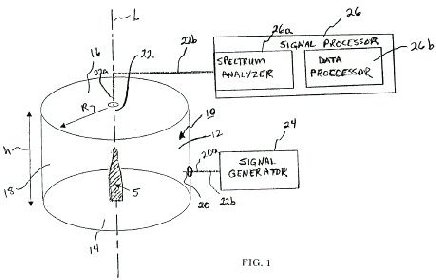Weatherall Technical Applications
Experimental Design
James C. Weatherall
A critical issue for personnel screening at security checkpoints is preventing flammable and explosive liquid materials from being carried into buildings and onto airplanes. Research on this problem led to a new type of bottle screener that uses the interaction of radio waves to evaluate the contents of glass or plastic bottles and determine whether they pose a threat. A prototype system was designed and built to validate the method. This work was supported by contract with the FAA and DHS.

left:
Method and Apparatus for Obtaining Spatial Information and Measuring the Dielectric Constant of an Object
Patent Number: US 7,378,849 B2
Computer Simulation
James C. Weatherall
High power generators of microwaves are used to project energetic pulses for the purpose of interfering with the function of electronic systems. Converting high voltages into electromagnetic waves can be done with magnetrons and relativistic particle beams in plasmas or dielectric devices - and rapidly rotating magnetized neutron stars (see Plasma Astrophysics below).

The operation of high power magnetrons were studied with computer simulation and led to a multi-hundred megawatt microwave magnetron and cascaded magnetron design. This work was performed at General Dynamics Corporation (now Raytheon AET).
right: Single Body Relativistic Magnetron
Patent Number: 5,159,241
Cascaded Relativistic Magnetron
Patent Number: 5,162,698
Plasma Astrophysics
James C. Weatherall
Some of the most intense emitters of radio waves in the universe are associated with radio pulsars, which are compact remnants of supernova stars. The electrodynamics of rapidly rotating neutron stars are understood to develop energetic magnetospheres and several mechanisms for beaming intense radio waves from these plasmas have been proposed. Putting these mechanisms to observational tests is more problematic. The challenge is to develop the radiation theory in enough detail to identify specific differentiating characteristics in the emission. One such test is based on the observed nanosecond-scale time structure of pulses. Models of the plasma turbulence emission mechanism were developed to predict features in the radio pulse of the Crab pulsar that have been observed with the Arecibo and VLA radio telescopes. The work was supported by NSF grants at the New Mexico Institute of Mining and Technology.

Time history of electrostatic wave showing spatial turbulence evolution. Plasma wave turbulence in a pulsar magnetosphere organizes into localized regions of intense field.
Nonlinear wave behavior may underly the radio emission and observed temporal structure of the radio pulse.
Geology
Kate Weatherall
For nearly half a century New Mexico was the principle producer, ~38%, of uranium in the United States. My research thesis discusses the possibility of uranium leaching into the water of Socorro County, New Mexico.
...the different soil types and processes of ground water transportation may encourage the leaching of uranium into the Socorro water supply. (p. 6)
The sources of uranium in Socorro are from both the extensive natural occurrences throughout the state as well as from the nearby testing of artillery shells, which contain depleted uranium. This paper discusses the various transport methods of uranium and, therefore, whether it may affect the local environment. (Geology research thesis under the guidance of Dr. David Norman, Geology Department, New Mexico Institute of Mining and Technology, 1997)
Technical Communication
Kate Weatherall
Because of the world wide web, information is no longer simply a collection of words, sentences and paragraphs. The user now experiences an interactive world to make connections between the written word, visual graphics, and associated links.
The effective web site has the ability to capture the audience almost spontaneously as it appears on the screen. (p. 35)
The technical communicator's role is to re-form text and often complex information into a user friendly structure. This structure must reflect the client's perspective, contain the richness of the subject matter, convey information succinctly, and provide a clear path allowing the user to absorb information and ideas in his or her own way.
If web sites are constructed correctly, they can embrace a wider audience -- the world -- and transcend barriers of education, culture, and gender. (p. 48)(Technical Communication thesis, 1997)